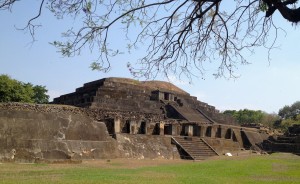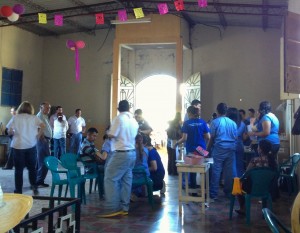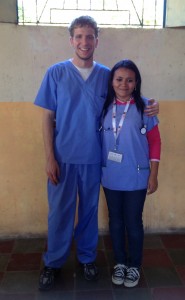Over spring break 2013, students and faculty from Baylor University’s medical humanities program traveled to the medical school of the Universidad Evangélica de El Salvador, a Christian university located in San Salvador, the capital city of El Salvador. It was the first medical mission trip ever organized by Baylor Medical Humanities. Jesse Hilton, a junior biochemistry major from Tolar, Texas, was one of the students who went on the trip, and we asked him to share with us what he experienced.
A Student’s Recap of Baylor’s First Medical Humanities Mission Trip to El Salvador
By Jesse Hilton
 Last September, I remember sitting in one of the first American Medical Student Association meetings of the new school year. That night we had the opportunity to hear from Ramona Curtis, Baylor’s director for civic engagement and educational development, and a leader of the Ghana community wellness mission trip Baylor undertakes each summer. I knew Baylor hosted mission trips, but I had no idea what actually happened on them.
Last September, I remember sitting in one of the first American Medical Student Association meetings of the new school year. That night we had the opportunity to hear from Ramona Curtis, Baylor’s director for civic engagement and educational development, and a leader of the Ghana community wellness mission trip Baylor undertakes each summer. I knew Baylor hosted mission trips, but I had no idea what actually happened on them.
In Curtis’ 30-minute lecture, I learned some important details about Baylor missions. Most importantly, I learned about the healthcare and medical focus of several of the yearly mission trips. The Ghana trip sounded great, but when I sat down and took a look at the Baylor missions website, I saw another trip that caught my eye.
The El Salvador medical missions trip the medical humanities department put together this year was the first of its kind at Baylor. Through the efforts of Dr. Lauren Barron, the associate director of medical humanities, Carlos Colón, the coordinator for worship initiatives at Baylor, and several other staff members, Baylor was going to El Salvador for the first time. My understanding was the general purpose of this inaugural mission was to pave the way for Baylor to make future trips to El Salvador.
I’m a junior biochemistry pre-med student here at Baylor, and for the past couple of years I’ve been looking for any opportunities to get involved in hospital and medical volunteer work. I love medicine and I know I want to be a physician. The trip we took to El Salvador gave me a unique chance to serve in my field of interest.
Beyond that, this mission fulfilled much more than the confused expectations I had when we left the ground at DFW Airport back in early March. I really didn’t know what to expect going into this trip. I had traveled to Costa Rica a few years ago so I was familiar with Central America, but this was my first time to be involved in a mission trip.
I remember in one of the trip preparation meetings back in January, Carlos said something that helped ease some of my worries about such a massive undertaking. Carlos is a veteran of the field, and through his experience, he said he learned to maintain a less strenuous schedule than some missions have done in the past.
What he said was verified by my experience on the mission. While we had our fair share of intense days across many different challenging environments, the trip leaders blessed us with time in the evenings to relax and reflect. We conducted 30-45 minute reflection and worship meetings in the evening of several of the days, but we still had the time to relax and hang out for a couple of hours each night to unwind and prepare for the day ahead.
Our first full day in the country we traveled out of San Salvador, the capital city we were staying in, and explored the beautiful countryside leading to Santa Ana. In Santa Ana, we experienced Salvadoran culture by attending Catholic Mass, and spent some time relaxing in Carlos’ house in the city. The urban environment there is much different from the United States, and I can only urge you to see for yourself to learn more about what I mean.
 Later that day we travelled about 30 minutes out to Chalchuapa, the small village where Carlos was born. The highlight of the evening was walking through the Mayan ruins right outside Chalchuapa.
Later that day we travelled about 30 minutes out to Chalchuapa, the small village where Carlos was born. The highlight of the evening was walking through the Mayan ruins right outside Chalchuapa.
At this point it may sound like this whole trip was a vacation, so I want to cut to the chase and discuss the real meat of the trip: what we did to serve in El Salvador and how I was changed as a person.
 The following day we went out to the medical school of Universidad Evangélica. We spent most of the day meeting some of the students, staff and doctors at the school. We had some very unique experiences that you would never get in the U.S. as an undergraduate student. These involved exploring the pathology lab and viewing — and even holding — some of the vast array of disease-ridden specimens and organs they collected for study. We also participated in one of their anatomy labs, where we had access to cadavers over 15 years old! We did much more at the university, but the next day involved an even more hands-on experience.
The following day we went out to the medical school of Universidad Evangélica. We spent most of the day meeting some of the students, staff and doctors at the school. We had some very unique experiences that you would never get in the U.S. as an undergraduate student. These involved exploring the pathology lab and viewing — and even holding — some of the vast array of disease-ridden specimens and organs they collected for study. We also participated in one of their anatomy labs, where we had access to cadavers over 15 years old! We did much more at the university, but the next day involved an even more hands-on experience.
 The following two days we went to a public hospital in San Salvador and did some amazing things with the physicians there. I ended up going through surgical rounds the first day, and witnessed several post-op procedures. The second day I stayed with Dr. Elaine Lambert, a rheumatologist and Baylor alumnus who teaches at Stanford. She blessed us with her presence on the trip. I spent most of the morning and afternoon at the clinic seeing several patients with Dr. Lambert and a few other students.
The following two days we went to a public hospital in San Salvador and did some amazing things with the physicians there. I ended up going through surgical rounds the first day, and witnessed several post-op procedures. The second day I stayed with Dr. Elaine Lambert, a rheumatologist and Baylor alumnus who teaches at Stanford. She blessed us with her presence on the trip. I spent most of the morning and afternoon at the clinic seeing several patients with Dr. Lambert and a few other students.
While these experiences were exciting and informative, I also saw some of the darker side of healthcare in El Salvador. The unfortunate circumstance of these days was my lack of ability to help in this underfunded, understaffed and under-resourced hospital. I felt very helpless, and sometimes I even felt as if I were in the way as we spent time there.
By this point, I felt happy with the certainty I felt with my career choice. The experiences I had in the hospital gave me confidence in my decision to become a physician. However, I also felt ashamed because I saw issues and suffering around me that I couldn’t do anything about.
Getting first-hand experience of the healthcare in El Salvador had given me new found gratitude for what we had in the United States, but I wanted to do something — anything — to feel like this mission was not just a one-way street of benefit for me.
 Luckily, that Thursday we set out in the early morning to go on a medical brigade to a village far outside of the city. This village had little access to medicine or healthcare of any kind, and most of the inhabitants were very poor. Dr. Pena, one of the physicians from Universidad Evangélica that came with us on the brigade, said something that gave me encouragement. He said the medical brigade we were undertaking would not have happened without the investment we at Baylor were putting in.
Luckily, that Thursday we set out in the early morning to go on a medical brigade to a village far outside of the city. This village had little access to medicine or healthcare of any kind, and most of the inhabitants were very poor. Dr. Pena, one of the physicians from Universidad Evangélica that came with us on the brigade, said something that gave me encouragement. He said the medical brigade we were undertaking would not have happened without the investment we at Baylor were putting in.
That little bit of knowledge gave me more drive to help out in any little ways I could find. We put together a clinic in a church building in the village that day, and in about five hours we saw over 200 patients treated by the physicians of the university, Dr. Barron and Dr. Lambert.
 I forged some great relationships that day with several Salvadorans, including a young doctor by the name of Reyna Almendarez. I spent most of the afternoon at her side learning as she diagnosed patients, and despite my poor Spanish and her poor English, we had a strong bond by the end of the day. Forging these kinds of great relationships was possibly the best part of my trip.
I forged some great relationships that day with several Salvadorans, including a young doctor by the name of Reyna Almendarez. I spent most of the afternoon at her side learning as she diagnosed patients, and despite my poor Spanish and her poor English, we had a strong bond by the end of the day. Forging these kinds of great relationships was possibly the best part of my trip.
We had some hiccups on the last day of our journey, as our plane was delayed more than a full day, and that led to some hard times returning to the states late Sunday night with school starting again the next morning. None of that was an issue, though, as this trip was one of the most defining times in my life.
 It’s been almost a month since we got back, and we’ve had multiple reunion meetings among students and staff of the mission trip. Some of us are already meeting to discuss fundraising on a broader and longer term for future trips to El Salvador. I will definitely do everything I can to return next year if we have the opportunity.
It’s been almost a month since we got back, and we’ve had multiple reunion meetings among students and staff of the mission trip. Some of us are already meeting to discuss fundraising on a broader and longer term for future trips to El Salvador. I will definitely do everything I can to return next year if we have the opportunity.
I left out so much of our experience, but that’s because so much cannot be explained through a journal like this.
I want to thank some of the people who played a huge part in making this such a successful undertaking for me and for Baylor: Dr. Lambert, Dr. Barron, Dr. Marcum, Carlos, Chad Mustain, and of course, all my peers. More than 20 of us gave our whole spring break for the chance to serve in this mission, and I know that none of us regretted it.
I will be directly involved in our future efforts in serving the wonderful but struggling country of El Salvador. But more importantly, I want to say I was directly involved in growing as a person through this journey. I know now more than ever I want to go into the medical field, and this trip has given me that strength.
———————–
PHOTO SUBJECTS, FROM TOP:
PHOTO 1 (top): The Baylor group poses at DFW Airport before departing for San Salvador
PHOTO 2: The Mayan ruins near Chalchuapa
PHOTO 3 (l to r): Sean Browning (Baylor freshman), Roger Navarrete (a medical student in El Salvador), and the author, Jesse Hilton
PHOTO 4 (l to r): Dr. Pena (a Salvadoran doctor) and Dr. Elaine Lambert (a Baylor alum now teaching medicine at Stanford)
PHOTO 5: The very busy clinic that Baylor students helped run in a small village church building
PHOTO 6 (l to r): Jesse Hilton and Dr. Reyna Almendarez (a Salvadoran doctor)
PHOTO 7 (bottom): The group that worked to make the village clinic a success
